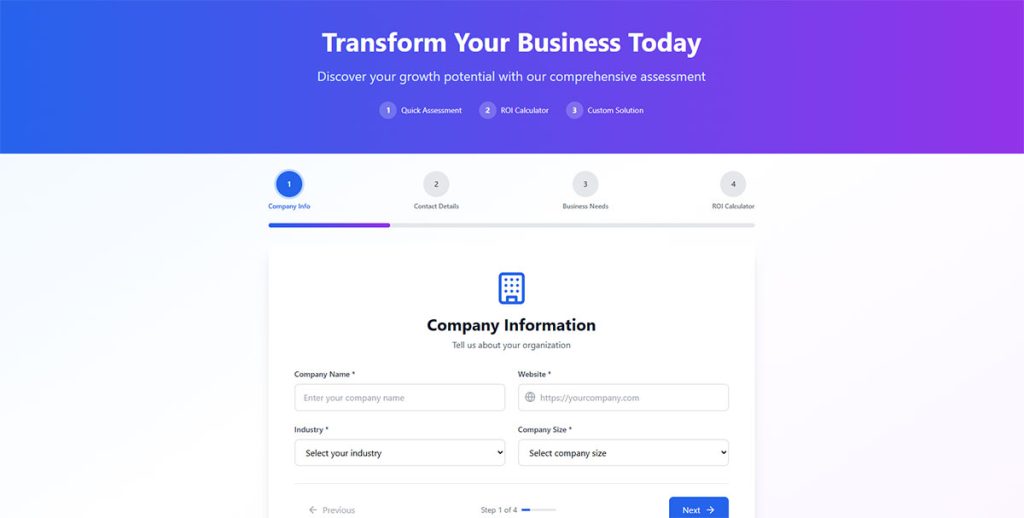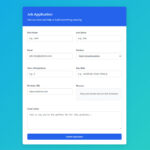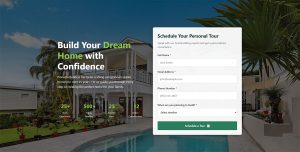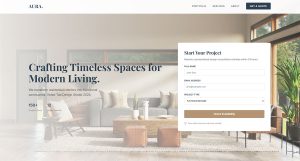Your model homes look stunning. Your craftsmanship speaks for itself. But none of that matters if qualified buyers never find you. Lead generation for home builders has shifted almost entirely…
Table of Contents
Most B2B websites generate fewer than 2% conversion rates from their forms. Yet companies like HubSpot and Salesforce consistently achieve 15-20% conversion rates using strategic form optimization.
Learning how to generate B2B leads using website forms transforms passive websites into active sales machines. Effective lead generation forms capture qualified prospects while filtering out unqualified traffic.
This guide reveals proven strategies that convert more visitors into sales-ready prospects. You’ll discover:
- Form design principles that boost conversions
- Strategic placement techniques for maximum visibility
- Lead qualification methods that identify buying intent
- Technical implementation for seamless CRM integration
- Advanced personalization tactics
Master these conversion rate optimization techniques and watch your marketing qualified leads multiply.
What are B2B Leads?
B2B leads are potential business clients or companies that may be interested in a product or service offered by another business. These leads are typically generated through marketing strategies like email campaigns, trade shows, or LinkedIn outreach, aiming to convert interest into sales or partnerships.
Designing High-Converting B2B Lead Forms and Strategic Placement
Form Structure and Layout Best Practices
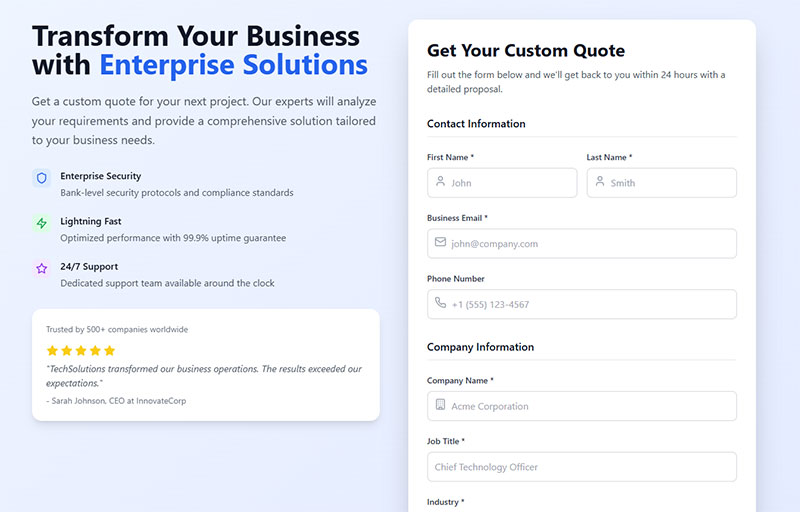
Single-column layouts beat multi-column designs every time. Your prospects scan vertically, not horizontally. Keep fields stacked in one clean line down the page.
Visual hierarchy matters. Place your most important fields first. Company name and email address should sit at the top. Secondary information like phone numbers can wait.
Mobile users make up 60% of B2B traffic. Your mobile forms need thumb-friendly touch targets. Buttons should be at least 44 pixels tall. Input fields require generous spacing.
Progressive disclosure keeps forms simple initially. Start with basic contact information. Add more fields as prospects engage deeper with your content. This technique works especially well for complex B2B sales cycles.
Field Arrangement Strategies
Left-align field labels above input boxes. Users read faster when labels follow this pattern. Right-aligned labels slow down completion rates by 50%.
Group related fields together:
- Contact Details: Name, email, phone
- Company Information: Organization, title, industry
- Project Specifics: Budget, timeline, requirements
White space between field groups creates visual breathing room. Cramped forms feel overwhelming to busy executives.
Form Field Selection and Optimization
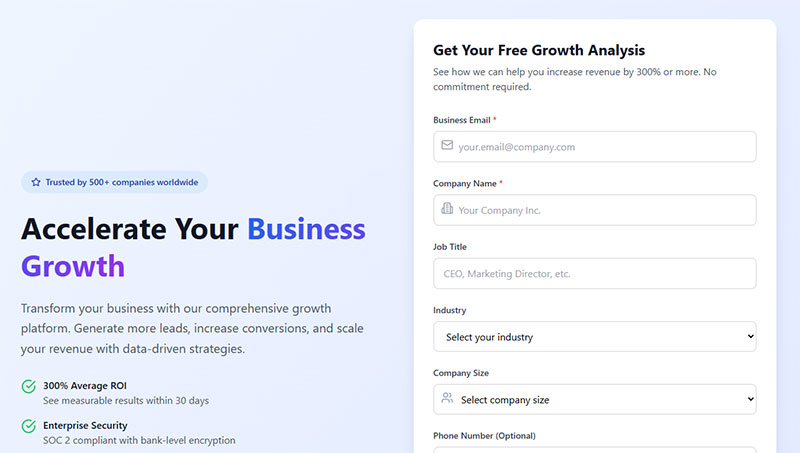
Three to five fields generate the highest conversion rates for B2B lead generation. Every additional field drops conversions by 10-15%. Ask only for information you’ll actually use.
Required fields should be clearly marked with red asterisks. Make email and company name mandatory. Keep phone numbers optional unless you plan immediate outreach.
Smart defaults speed up completion. Pre-populate country fields based on IP location. Use dropdown menus for industry selection to maintain data consistency.
Best Performing B2B Field Types
Dropdown menus work perfectly for:
- Industry selection
- Company size ranges
- Budget categories
- Geographic regions
Text fields handle:
- Company names
- Job titles
- Specific requirements
- Custom messages
Checkboxes capture:
- Product interests
- Marketing preferences
- Newsletter subscriptions
Auto-population from email domains can identify company names automatically. Tools like Clearbit or HubSpot provide this functionality seamlessly.
Creating Compelling Form Headlines and Copy
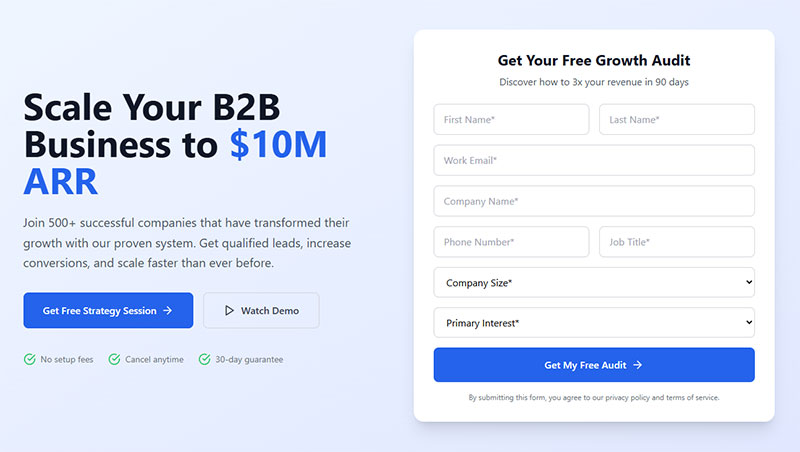
Headlines should promise immediate value. “Get Your Free Industry Report” converts better than “Contact Us.” Benefit-focused language drives action.
Action-oriented button text boosts click-through rates:
- “Download Now” beats “Submit”
- “Get My Free Guide” outperforms “Send”
- “Start Free Trial” converts better than “Register”
Trust signals build confidence near form buttons. Add client logos, security badges, or testimonials. “Join 5,000+ Marketing Directors” creates social proof.
Copy should address specific pain points. “Struggling with lead qualification?” speaks directly to B2B challenges. Generic messaging gets ignored.
Psychological Triggers That Work
Urgency creates action. “Limited time offer” or “Download expires in 24 hours” motivate immediate completion. Use sparingly to maintain credibility.
Authority positioning helps with enterprise prospects. “Used by Fortune 500 companies” or “Trusted by industry leaders” adds weight to your offering.
Visual Design Elements That Boost Conversions
Color psychology drives behavior. Orange and red buttons create urgency. Blue builds trust for financial services. Green suggests growth and success.
High contrast between buttons and backgrounds improves visibility. A bright orange call-to-action button on a white background gets noticed instantly.
Typography choices affect readability. Sans-serif fonts like Arial or Helvetica work best for forms. Avoid decorative fonts that slow reading speed.
Icons guide user attention effectively:
- Envelope icons near email fields
- Phone icons beside contact numbers
- Lock icons for security assurance
- Checkmark icons for confirmation
Strategic Form Placement and Timing
Generous spacing around form elements reduces cognitive load. Crowded designs overwhelm decision-makers who process information quickly.
Border styles should be subtle. Thick, colorful borders distract from content. Thin gray lines provide structure without visual noise.
High-Impact Form Placement Locations
Above-the-fold homepage positioning captures immediate attention. Place your primary lead generation form in the top-right corner where eyes naturally land.
Landing pages dedicated to specific campaigns convert at 15-20% rates. Remove navigation menus and focus entirely on form completion.
Blog posts offer natural integration opportunities. Add relevant contact forms at the end of helpful articles when readers feel most engaged.
About page placement works for relationship-driven B2B sales. Prospects research your team before making contact. Strike while interest peaks.
Footer forms capture departing visitors. Keep these simple with just email capture for newsletter signups or resource downloads.
Content Page Integration Tactics
Mid-article placement works for long-form content. Insert lead magnets after delivering substantial value but before the conclusion.
Sidebar forms complement main content without disrupting reading flow. Keep these compact with minimal fields.
Resource pages should feature prominent download forms. Gated content like whitepapers or case studies justify information exchange.
Pop-Up and Overlay Form Strategies
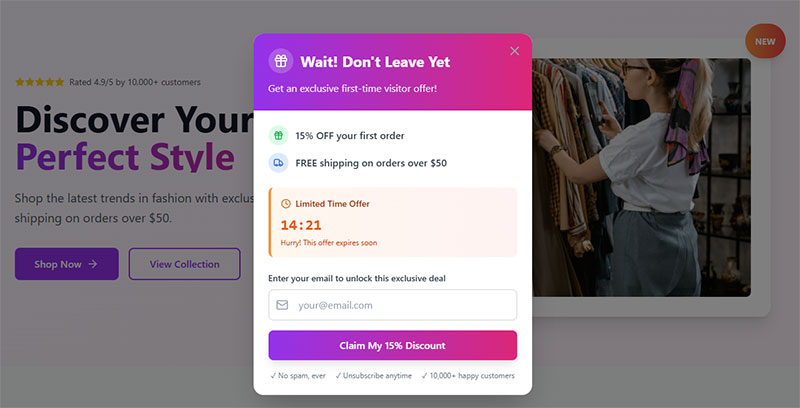
Exit-intent popups catch visitors before they leave. These convert at 3-5% rates when offering valuable content.
Timed popup forms should appear after 60-90 seconds of engagement. Earlier timing feels pushy to professional audiences.
Scroll-triggered forms activate when users reach 70% page depth. This timing indicates genuine interest in your content.
Page-specific targeting improves relevance. Show pricing calculators on service pages. Display case study downloads on solution pages.
Popup Design Best Practices
Easy close buttons respect user choice. Make X buttons prominent and functional. Frustrated visitors never convert.
Mobile popup considerations matter crucially. Ensure forms fit screen sizes without horizontal scrolling. Test across different devices.
Overlay transparency should be 70-80%. Complete darkness feels aggressive. Light overlays maintain page context.
Content-Gated Form Implementation
Choose gating strategically. High-value content like industry reports justify information exchange. Basic blog posts should remain open.
Partial content previews build interest before gating. Show the first page or executive summary. Tease valuable insights waiting behind the form.
Multi-step forms reduce abandonment for complex B2B sales. Start with basic contact details. Add qualifying questions in subsequent steps.
Progressive profiling prevents form fatigue. Capture different information on repeat visits. Build complete prospect profiles over time.
Content Value Assessment
Research reports convert exceptionally well for B2B audiences. Industry benchmarks, trend analysis, and competitive intelligence drive downloads.
Templates and checklists provide immediate utility. Marketing calendar templates or sales process checklists get downloaded frequently.
Case studies work best when prospect-specific. Target similar company sizes or industries for maximum relevance.
Tool comparisons help buying committees make decisions. Software evaluation guides or vendor comparison charts generate qualified leads.
Advanced Placement Techniques
Contextual placement matches forms to content themes. HR articles should feature HR software forms. Marketing content pairs with marketing tool offers.
Geographic targeting customizes experiences. Show regional case studies or local contact information based on visitor location.
Industry-specific forms improve qualification. Manufacturing prospects see manufacturing-focused content offers. Healthcare visitors get healthcare resources.
Behavioral targeting adapts to user actions. Return visitors see different offers than first-time browsers. Engaged readers get premium content access.
Cross-Channel Integration
Email signature links drive traffic to targeted landing page forms. Sales teams can promote specific resources during outreach.
Social media integration extends form reach. LinkedIn posts can link to gated content forms. Twitter campaigns drive traffic to conversion pages.
Webinar registration forms capture engaged prospects. Live events create urgency and demonstrate expertise simultaneously.
Event coordination connects offline interactions to online forms. Trade show follow-up drives prospects to specific landing pages.
Lead Magnets, Value Propositions, and Technical Implementation
Creating Irresistible B2B Lead Magnets
Industry reports generate the highest download rates for B2B prospects. Decision-makers crave data-driven insights about their markets. Benchmark studies, trend analysis, and competitive intelligence drive consistent conversions.
Templates save time for busy professionals. Marketing calendar templates, sales process checklists, and project planning worksheets provide immediate utility. Practical tools get shared internally, extending your reach.
Case studies prove real-world results. Success stories from similar companies build trust with prospective buyers. Include specific metrics like “increased conversion rates by 127%” or “reduced acquisition costs by $50,000 annually.”
High-Converting Content Types
Tool comparisons help buying committees make informed decisions:
- Software evaluation matrices
- Vendor comparison guides
- Feature analysis spreadsheets
- ROI calculation tools
Webinars create engagement beyond static content. Live events allow real-time interaction with prospects. Interactive Q&A sessions build relationships that lead to sales conversations.
Buyer guides address specific purchase decisions. “Ultimate Guide to CRM Selection” or “Marketing Automation Buying Checklist” attract prospects actively researching solutions.
Research studies establish thought leadership. Original surveys about industry challenges position your company as an authority. Share methodology and raw data for credibility.
Creating Value Propositions That Convert
Problem-focused statements resonate with B2B buyers. “Tired of manual lead scoring?” speaks directly to marketing directors’ pain points. Address specific operational challenges.
Benefit-driven messaging quantifies outcomes. “Generate 40% more qualified leads” beats vague promises about “improved performance.” Numbers create concrete expectations.
Urgency tactics motivate immediate action:
- Limited-time access to exclusive content
- Early-bird pricing for events
- Bonus materials for first 100 downloads
- Seasonal relevance (“2026 Planning Guide”)
Personalization based on visitor behavior increases relevance. Return visitors see different offers than first-time browsers. Industry-specific landing pages speak directly to sector challenges.
Psychological Triggers for B2B Audiences
Authority positioning builds credibility with enterprise prospects. “Trusted by Fortune 500 companies” or “Used by 10,000+ marketing professionals” creates social proof.
Scarcity drives action when authentic. “Only 50 spots available” works for workshops. “Limited research participant slots” applies to exclusive studies.
Loss aversion motivates faster decisions. “Don’t miss out on competitive insights” or “Avoid costly implementation mistakes” tap into fear of falling behind.
Matching Lead Magnets to Buyer Journey Stages
Awareness stage prospects need educational content:
- Industry trend reports
- Problem identification guides
- “How-to” resources
- Educational webinars
Consideration stage buyers compare solutions actively. Provide comparison tools, feature matrices, and vendor evaluation guides. Lead magnets should help narrow choices.
Decision stage materials support final purchasing decisions:
- ROI calculators
- Implementation timelines
- Case studies from similar companies
- Free trial access
Customer retention forms capture expansion opportunities. Existing clients download advanced guides, attend user conferences, or access premium support resources.
Technical Implementation and Integration
Map content offers to prospect research patterns. Early buyers seek broad market insights. Advanced prospects want detailed implementation guidance.
Progressive content builds relationships over time. Start with general industry reports. Follow with specific solution guides. End with custom consultation offers.
Form Builder Tools and Platforms
Native website builders like WordPress offer basic form functionality. WordPress forms handle simple contact collection but lack advanced features.
Third-party solutions provide robust capabilities:
- HubSpot: Comprehensive CRM integration and automation
- Mailchimp: Email marketing focus with basic lead capture
- Typeform: Conversational form experiences
- Gravity Forms: WordPress plugin with advanced logic
Custom HTML development offers complete control. Developers can create unique designs and functionality. Requires technical expertise but provides unlimited flexibility.
WordPress contact form plugins bridge the gap between simplicity and functionality. Popular options include Contact Form 7, Ninja Forms, and WPForms.
Platform Selection Criteria
Integration capabilities matter most for B2B workflows. Forms must connect seamlessly with existing CRM systems and marketing automation platforms.
Customization options affect brand consistency. Forms should match website design and user experience standards.
Analytics and reporting features track performance metrics. A/B testing capabilities optimize conversion rates over time.
Mobile responsiveness ensures forms work across all devices. B2B prospects increasingly use tablets and smartphones for research.
CRM and Marketing Automation Integration
Salesforce integration connects form submissions directly to sales pipelines. Automatic lead assignment routes prospects to appropriate sales representatives based on territory or industry.
HubSpot workflows trigger immediate follow-up sequences:
- Welcome email series for new subscribers
- Demo scheduling for qualified prospects
- Content nurturing for early-stage leads
- Sales notification for high-value opportunities
Pardot specializes in B2B marketing automation. Advanced lead scoring assigns points based on form interactions, content downloads, and website behavior.
Data Synchronization Best Practices
Real-time sync prevents data loss and duplicate records. Immediate transfer ensures sales teams can follow up while interest remains high.
Field mapping connects form data to correct CRM properties. Company name maps to account records. Job titles populate contact roles automatically.
Automated lead scoring qualifies prospects instantly:
- Job title weights (C-level = 50 points, Manager = 20 points)
- Company size scoring (Enterprise = 40 points, SMB = 10 points)
- Engagement tracking (Demo request = 100 points, Newsletter = 5 points)
Error handling prevents lost leads when integrations fail. Backup email notifications ensure human review of form submissions.
Analytics and Tracking Setup
Google Analytics goal configuration tracks form completion rates. Set up destination goals for thank-you pages. Monitor conversion funnels to identify drop-off points.
Conversion tracking measures ROI across channels:
- UTM parameters identify traffic sources
- Campaign tracking attributes leads to specific efforts
- Multi-touch attribution shows complete customer journeys
Heat mapping tools like Hotjar reveal user behavior patterns. See where prospects click, scroll, and abandon forms. Form UX design improves based on actual usage data.
A/B testing infrastructure enables continuous optimization. Test headlines, field arrangements, button colors, and form lengths systematically.
Key Performance Metrics
Form conversion rates measure effectiveness across different placements and designs. Track performance by traffic source, device type, and audience segment.
Lead quality metrics assess form performance beyond volume:
- Lead-to-opportunity conversion rates
- Sales cycle length for form-generated leads
- Customer lifetime value from different form types
Page performance analytics identify optimization opportunities. Forms with high traffic but low conversions need design improvements.
User flow analysis shows how prospects interact with forms. Identify common paths to completion and barriers causing abandonment.
Advanced Integration Techniques
Zapier connections link forms to hundreds of business applications. Automatically create Slack notifications, update Google Sheets, or trigger custom workflows.
API integrations enable custom connections between forms and proprietary systems. Development teams can build specific functionality for unique business requirements.
Webhooks provide real-time data transfer to external systems. Instant notifications enable immediate follow-up actions across multiple platforms.
Conditional logic personalizes form experiences. Show relevant fields based on previous answers. Branch prospects to different follow-up sequences automatically.
Security and Compliance Integration
Form security protects sensitive prospect data. SSL certificates encrypt data transmission. CAPTCHA prevents spam submissions.
GDPR compliant forms include proper consent mechanisms. Clear privacy policy links and data processing explanations meet regulatory requirements.
Data validation prevents incomplete or incorrect submissions. Real-time checking ensures email addresses are properly formatted and required fields are completed.
Backup systems protect against data loss. Regular exports to secure storage ensure lead information remains accessible even during system failures.
Form Optimization, Testing Strategies, and Lead Quality Management
A/B Testing Your Lead Forms
Test one element at a time for accurate results. Headlines, button colors, field arrangements, and form lengths each deserve separate experiments. Simultaneous changes make it impossible to identify winning factors.
Critical elements to test systematically:
- Headlines and value propositions
- Call-to-action button text and colors
- Number of form fields
- Field labels and placeholder text
- Social proof placement
- Form layout and design
Set proper test parameters before launching. Minimum sample size of 1,000 visitors per variation ensures statistical significance. Run tests for complete business cycles (typically 2-4 weeks for B2B).
Statistical significance requires 95% confidence levels. Tools like Optimizely and Google Optimize calculate this automatically. Don’t stop tests early even if one variation appears to be winning.
Test Results Interpretation
Conversion rate improvements above 20% indicate significant wins. Smaller gains might result from random variation rather than actual performance differences.
Secondary metrics matter beyond conversion rates. Lead quality, cost per acquisition, and downstream sales conversions provide complete performance pictures.
Document test results thoroughly. Track winning variations, test durations, and confidence levels. Build a knowledge base of optimization insights for future campaigns.
Failed tests provide valuable insights. Understanding what doesn’t work prevents future mistakes and refines testing strategies.
Conversion Rate Optimization Techniques
Form field reduction consistently improves conversion rates. Each additional field decreases completions by 10-15%. Ask only for information you’ll immediately use in follow-up conversations.
Multi-step forms work better for complex B2B sales. Break long forms into logical sections. Start with basic contact information before requesting detailed requirements.
Social proof placement near submit buttons builds confidence:
- Customer logos
- Testimonials from similar companies
- “Join 5,000+ marketing directors” messaging
- Trust badges and security certifications
Error message optimization prevents abandonment. Clear, helpful guidance keeps prospects engaged when problems occur. Form error messages should explain exactly what needs fixing.
Progressive Profiling Strategies
Capture different information on repeat visits. First-time visitors provide basic contact details. Return visitors share budget ranges or project timelines.
Behavioral triggers determine when to ask for more information. Prospects who download multiple resources show higher engagement and willingness to share details.
Smart defaults reduce friction for returning visitors. Pre-populate known information like company names and job titles automatically.
Mobile Form Optimization
Touch-friendly design accommodates finger navigation. Buttons need minimum 44-pixel height. Input fields require generous spacing to prevent accidental taps.
Mobile-specific considerations:
- Single-column layouts only
- Large, prominent submit buttons
- Minimal scrolling requirements
- Auto-focus on first field
- Simplified field types
Keyboard optimization improves user experience. Email fields should trigger email keyboards. Phone fields activate numeric keypads automatically.
Cross-device completion tracking helps understand user journeys. Many B2B prospects start forms on mobile devices but complete them on desktop computers.
Mobile Testing Priorities
Real device testing beats desktop simulation. iPhones, Android phones, and tablets each behave differently. Test across multiple screen sizes and operating systems.
Load speed affects mobile conversion rates more than desktop. Optimize images, minimize scripts, and use content delivery networks for faster loading.
Lead Quality Management and Nurturing
Lead Qualification and Scoring
Demographic scoring identifies ideal prospects:
- Company size (Enterprise: 50 points, Mid-market: 30 points, SMB: 10 points)
- Industry relevance (Target sectors: 40 points, Adjacent markets: 20 points)
- Job title influence (C-level: 50 points, Director: 35 points, Manager: 20 points)
- Geographic location (Target territories: 30 points, Secondary markets: 15 points)
Firmographic data provides additional qualification layers. Revenue ranges, employee counts, and technology usage patterns help prioritize follow-up efforts.
Behavioral scoring tracks engagement levels. Form completion, content downloads, email opens, and website visits indicate purchase intent.
Scoring Model Development
Predictive analytics improve scoring accuracy over time. Analyze closed deals to identify common characteristics of successful prospects.
Negative scoring removes unqualified leads. Personal email addresses, students, and competitors receive point deductions.
Regular model updates reflect changing market conditions. Quarterly reviews ensure scoring criteria match current buyer behaviors.
Lead grading systems combine fit and interest scores. “A” prospects show high fit and high interest. “D” prospects lack both qualification criteria.
Immediate Response and Follow-Up Strategies
Automated confirmation emails set proper expectations. Include next steps, timeline for follow-up, and relevant resources. Form submission confirmation messages maintain engagement momentum.
Thank you page optimization continues the conversation:
- Related content recommendations
- Social media follow buttons
- Calendar booking links
- Additional resource downloads
Sales team notification systems enable rapid response. Real-time alerts for high-value prospects ensure immediate follow-up while interest remains high.
Lead routing assigns prospects to appropriate representatives. Geographic territories, industry expertise, and account size determine routing rules.
Response Time Impact
Five-minute follow-up increases conversion rates by 900% compared to 30-minute delays. Speed directly correlates with qualification and conversion success.
Automated scheduling links remove friction from demo requests. Calendly and similar tools allow immediate meeting booking without back-and-forth emails.
Weekend and after-hours responses show dedication. Automated systems can acknowledge submissions and promise Monday morning follow-up.
Nurturing Form-Generated Leads
Email sequence development guides prospects through consideration stages. Educational content builds trust before introducing sales messages.
Effective nurturing workflows:
- Welcome series for new subscribers
- Industry-specific content tracks
- Behavioral triggers based on engagement
- Re-engagement campaigns for inactive leads
Personalized content delivery improves engagement rates. Dynamic content blocks show relevant case studies, product information, or geographic offers.
Multi-channel nurturing approaches reach prospects across preferred communication methods. Email, LinkedIn outreach, and phone calls create multiple touchpoints.
Content Sequencing Strategy
Educational content comes first. Industry insights, best practices, and trend analysis establish credibility without selling.
Problem-solution content follows educational foundation. Address specific challenges prospects face and introduce relevant solutions gradually.
Decision-stage content supports final purchasing decisions:
- ROI calculators
- Implementation guides
- Customer success stories
- Free trial offers
Lead re-engagement campaigns target inactive prospects. “We miss you” emails or new content announcements can restart conversations.
Advanced Lead Management
Lead scoring automation routes prospects to appropriate sales stages. High-scoring leads trigger immediate sales alerts. Lower scores enter nurturing workflows automatically.
CRM integration ensures seamless data flow. Form submissions populate contact records, trigger workflows, and update lead statuses across systems.
Attribution tracking connects form conversions to revenue outcomes. Multi-touch attribution shows which touchpoints contribute to closed deals.
Conversion funnel analysis identifies optimization opportunities. Track prospects from form submission through opportunity creation to deal closure.
Performance Monitoring
Real-time dashboards track key metrics across all forms. Conversion rates, lead quality scores, and pipeline contribution provide comprehensive views.
Monthly reporting compares form performance across traffic sources, content types, and campaign variations. Identify top-performing combinations for scaling.
Lead velocity measurements show how quickly prospects move through sales stages. Fast-moving leads indicate effective qualification and nurturing processes.
Compliance, Data Protection, and ROI Measurement
GDPR and Privacy Compliance
GDPR compliant forms require explicit consent mechanisms. Checkbox agreements cannot be pre-selected. Users must actively opt-in to data processing.
Essential compliance elements:
- Clear consent language explaining data usage
- Separate checkboxes for different processing purposes
- Privacy policy links prominently displayed
- Right to withdraw consent information
- Data retention timeline disclosure
Cookie consent affects form functionality. Analytics tracking and marketing automation require separate consent categories. Unbounce and other platforms provide built-in compliance tools.
Data processing transparency builds trust with enterprise prospects. Explain how information gets used, who accesses it, and where it’s stored. B2B buyers appreciate clear data handling policies.
Regional Compliance Requirements
CCPA applies to California residents and businesses. Similar consent mechanisms work across most privacy frameworks. Consistent global approaches simplify compliance management.
Industry-specific regulations add complexity. Healthcare forms need HIPAA compliance. Financial services require additional security measures. Research sector-specific requirements thoroughly.
International data transfers require proper safeguards. Standard contractual clauses protect EU data sent to third countries. Privacy Shield alternatives like adequacy decisions provide transfer mechanisms.
Anti-Spam and Security Measures
CAPTCHA implementation blocks automated submissions. Google reCAPTCHA v3 works invisibly for legitimate users while stopping bots effectively. Balance security with user experience.
Honeypot techniques catch spam without user interaction:
- Hidden fields invisible to humans
- CSS positioning tricks
- JavaScript-based detection
- Time-based submission analysis
Form validation prevents malicious inputs. Server-side validation catches attempts to bypass client-side checks. Sanitize all submitted data before processing.
SSL certificates encrypt data transmission between browsers and servers. Green padlock icons reassure prospects about information security. Enterprise buyers expect encrypted connections.
Advanced Security Measures
Rate limiting prevents brute force attacks. Limit form submissions per IP address and time period. Legitimate users rarely submit multiple forms rapidly.
Input sanitization removes potentially harmful code. SQL injection and cross-site scripting attempts get filtered automatically. Never trust user input without validation.
Database security protects stored lead information. Encrypted storage, access controls, and regular backups prevent data breaches. Security incidents damage reputation and compliance standing.
Data Storage and Management
Secure collection practices start with minimal data gathering. Collect only information needed for immediate business purposes. Additional data can be gathered during nurturing processes.
Data retention policies define storage timeframes:
- Active prospects: Ongoing storage while engaged
- Inactive leads: 2-3 year retention for reactivation
- Unsubscribed contacts: Suppression list maintenance
- Customers: Extended retention for relationship management
User access rights enable self-service data management. Provide preference centers where prospects update information, download collected data, or request deletion.
Third-party sharing agreements require careful consideration. CRM systems, email platforms, and analytics tools all access form data. Document all sharing relationships clearly.
Data Quality Management
Regular data cleaning maintains database accuracy. Remove duplicates, update changed information, and flag incomplete records. Clean data improves campaign performance and compliance.
Automated data enrichment fills information gaps. Tools like ZoomInfo and Clearbit append company details, job titles, and contact information automatically.
Measuring Success and ROI
Key Performance Indicators for Form Performance
Form conversion rates measure basic effectiveness across different placements and designs. Track performance by traffic source, device type, and audience segment.
Lead quality metrics assess value beyond volume:
- Lead-to-opportunity conversion rates
- Sales cycle length for form-generated prospects
- Customer lifetime value from different form types
- Pipeline contribution percentage
Cost per lead calculations guide budget allocation. Include form development costs, platform fees, and content creation expenses. Compare acquisition costs across channels.
Lead-to-customer conversion rates reveal true ROI. Track prospects from initial form submission through deal closure. Identify which forms generate the highest-value customers.
Performance Benchmarking
Industry benchmarks provide context for results. B2B form conversion rates typically range from 2-5%. Landing page forms convert higher than sidebar placements.
Seasonal patterns affect conversion performance. Q4 budget cycles drive higher engagement. Summer months often show decreased activity. Plan campaigns accordingly.
Competitor analysis reveals optimization opportunities. Monitor rival companies’ form strategies, content offers, and conversion tactics. Adapt successful approaches to your context.
Attribution and Source Tracking
UTM parameter implementation tracks campaign performance accurately. Use consistent naming conventions across all marketing channels. Google Analytics processes UTM data automatically.
Multi-touch attribution shows complete customer journeys:
- First-touch attribution credits initial discovery
- Last-touch attributes conversion to final interaction
- Linear models distribute credit equally across touchpoints
- Time-decay gives more weight to recent interactions
Channel performance analysis identifies top-performing traffic sources. Organic search, paid advertising, email campaigns, and social media each contribute differently to form conversions.
ROI calculation methods vary by business model. SaaS companies track monthly recurring revenue. Service businesses focus on project values. Manufacturing considers lifetime customer value.
Advanced Attribution Modeling
Cross-device tracking connects mobile research to desktop conversions. Google Analytics 4 and similar platforms link user journeys across devices automatically.
Offline attribution connects digital forms to phone calls and in-person meetings. Call tracking numbers and CRM integration provide complete conversion pictures.
View-through conversions credit display advertising exposure. Prospects often see ads before directly visiting websites and completing forms. Include assisted conversions in performance analysis.
Reporting and Analytics Dashboards
Real-time monitoring enables quick optimization responses. Track form performance hourly during campaign launches. Identify and fix issues immediately.
Executive dashboards focus on business outcomes:
- Monthly lead volume and quality trends
- Pipeline contribution from forms
- Cost per acquisition by channel
- Revenue attribution to form campaigns
Monthly reporting compares performance across time periods. Seasonal adjustments and trend analysis guide strategy refinements. Include competitive intelligence when available.
Data visualization improves stakeholder understanding. Charts showing conversion funnels, geographic performance, and demographic breakdowns communicate results effectively.
Automated Reporting Systems
Scheduled reports ensure consistent stakeholder communication. Weekly summaries for marketing teams. Monthly executive briefings. Quarterly board presentations require different detail levels.
Alert systems notify teams about performance changes. Conversion rate drops, spam increases, or technical errors trigger immediate notifications. Rapid response prevents extended issues.
Integration with business intelligence platforms provides comprehensive analysis. Tools like Tableau and Power BI combine form data with sales information, creating complete customer journey views.
Advanced Form Strategies and Techniques
Personalization and Dynamic Content
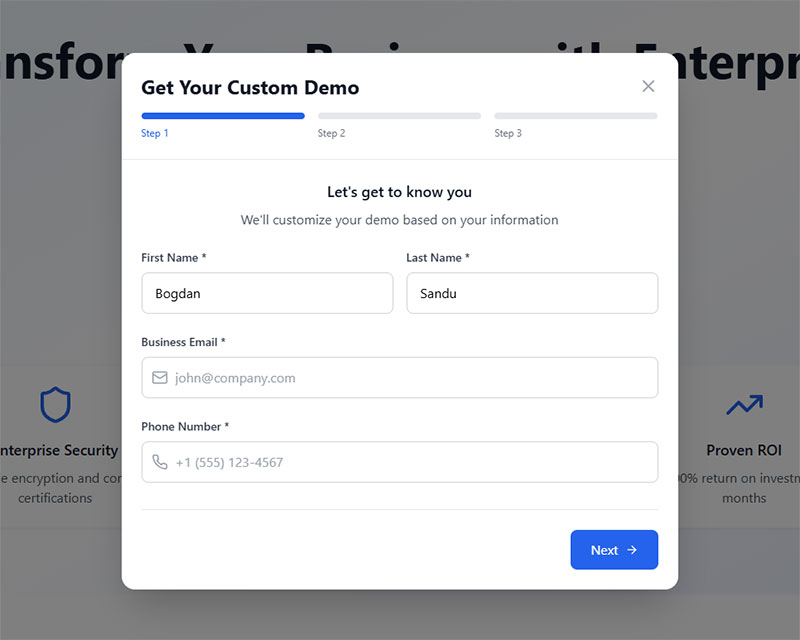
Visitor-based customization transforms generic forms into targeted experiences. First-time visitors see introductory messaging. Return prospects get advanced content offers.
Dynamic content elements:
- Industry-specific headlines and value propositions
- Geographic location-based contact information
- Company size-appropriate content offers
- Job title-relevant form fields
Industry-specific variations speak directly to sector challenges. Healthcare forms emphasize compliance benefits. Manufacturing content focuses on operational efficiency. Financial services highlight security features.
Geographic personalization shows local relevance. Display regional case studies, local phone numbers, and timezone-appropriate webinar times. IP-based detection enables automatic customization.
Behavioral Targeting Implementation
Page visit history triggers relevant form offers. Prospects viewing pricing pages see demo request forms. Resource library visitors get content subscription options.
Engagement scoring determines form complexity. Highly engaged visitors receive detailed qualification forms. Casual browsers get simple email capture requests.
Return visitor modifications:
- Hide already-completed fields
- Offer premium content upgrades
- Show account-specific information
- Provide direct contact options
Referral source detection customizes messaging. Social media traffic sees casual, engaging copy. Search engine visitors get direct, benefit-focused headlines.
Interactive and Engaging Form Elements
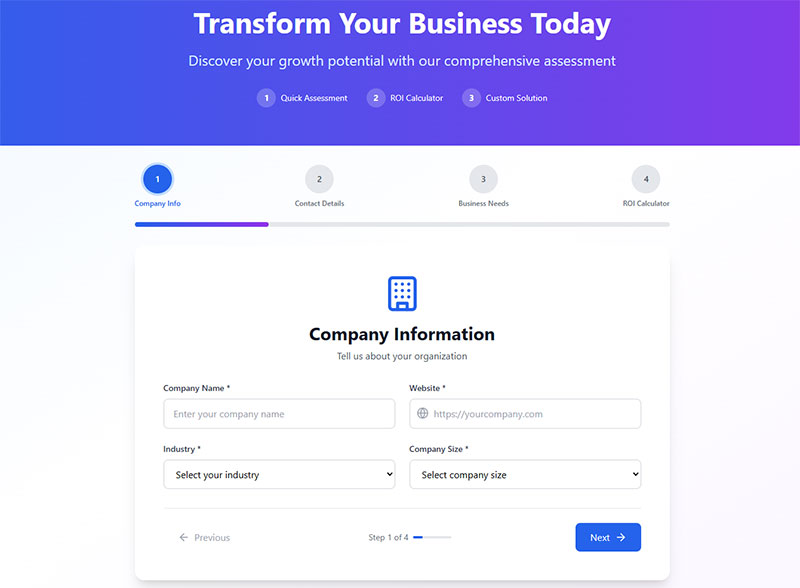
Conditional logic creates personalized experiences. Show relevant fields based on previous answers. Branch prospects to different follow-up sequences automatically.
Progress indicators reduce abandonment in multi-step forms. Visual progress bars show completion status. Step numbering sets clear expectations.
Interactive calculators provide immediate value:
- ROI estimation tools
- Cost savings calculators
- Implementation timeline assessments
- Resource requirement estimators
Gamification elements increase engagement. Points for form completion, badges for information sharing, or progress levels create interactive experiences.
Assessment and Quiz Integration
Diagnostic assessments qualify prospects while providing value. Marketing maturity evaluations, security audits, or process efficiency reviews generate qualified leads.
Personality assessments work for relationship-driven B2B sales. Leadership style evaluations or communication preference quizzes build rapport with prospects.
Results-based follow-up sequences deliver personalized recommendations. High scores trigger immediate sales contact. Lower scores enter educational nurturing workflows.
Cross-Channel Form Integration
Social media integration extends form reach beyond websites. LinkedIn Lead Gen Forms capture prospects without leaving the platform. Facebook lead ads work similarly for broader audiences.
Email signature optimization:
- Direct links to specific landing pages
- QR codes for mobile form access
- Compelling call-to-action copy
- Campaign-specific tracking parameters
Offline-to-online strategies connect physical interactions to digital forms. QR codes on business cards link to mobile-optimized contact forms. Trade show follow-up drives prospects to specific landing pages.
Event coordination integrates seamlessly with digital campaigns. Webinar registration forms capture engaged prospects. Follow-up surveys gather additional qualification information.
Omnichannel Experience Design
Consistent branding across all form touchpoints builds recognition. Maintain visual design, messaging tone, and value propositions across channels.
Cross-device optimization ensures seamless experiences. Prospects often research on mobile devices but complete forms on desktop computers. Save partial progress automatically.
Channel-specific adaptations:
- Social media forms use casual, engaging language
- Email forms leverage existing subscriber relationships
- Paid advertising forms match ad messaging exactly
- Organic search forms address specific query intent
Advanced Technical Implementation
API integrations enable custom functionality beyond standard form builders. Connect directly to proprietary systems, custom databases, or specialized workflows.
Webhook automation triggers real-time actions across multiple platforms. Form submissions create Slack notifications, update project management tools, or initiate custom workflows.
Machine learning integration:
- Predictive lead scoring based on form data
- Automated content recommendations
- Dynamic field suggestions
- Spam detection algorithms
Zapier connections link forms to hundreds of business applications. Create automated workflows without custom development. Scale integration capabilities rapidly.
Advanced Analytics Implementation
Custom event tracking measures micro-conversions within forms. Track field completions, section progress, and abandonment points precisely.
Heat mapping reveals user interaction patterns. Hotjar and Crazy Egg show where prospects click, scroll, and hesitate. Form design improvements follow actual usage data.
Conversion funnel optimization:
- Identify specific abandonment triggers
- Test field ordering variations
- Optimize error message placement
- Improve mobile interaction patterns
Cohort analysis tracks form performance over time. Compare conversion rates across user segments, traffic sources, and campaign periods.
Conversational Form Experiences
Conversational forms mimic natural dialogue patterns. One question appears at a time. Responses guide subsequent questions automatically.
Chatbot integration provides immediate assistance during form completion. Answer questions, clarify requirements, or schedule follow-up conversations instantly.
Voice interface considerations:
- Simple, clear question phrasing
- Multiple choice options when possible
- Error correction capabilities
- Accessibility compliance
Natural language processing interprets open-text responses. Extract key information automatically. Route prospects based on written requirements or challenges.
Personality-Driven Interactions
Tone adaptation matches company culture. Professional services use formal language. Creative agencies adopt casual, friendly approaches.
Micro-interactions provide engaging feedback. Checkmarks appear after field completion. Progress animations show advancement through multi-step processes.
Emotional engagement techniques:
- Empathetic error messages
- Encouraging progress notifications
- Celebration animations for completion
- Personalized thank you messages
Advanced Lead Qualification
Progressive profiling builds complete prospect pictures over time. Capture basic information initially. Gather detailed requirements during nurturing sequences.
Smart field logic prevents repetitive questions. Known information populates automatically. New questions focus on missing qualification criteria.
Behavioral qualification triggers:
- Content download patterns
- Website engagement duration
- Email interaction rates
- Social media activity levels
Intent signal detection identifies ready-to-buy prospects. Budget discussions, timeline questions, and implementation inquiries trigger immediate sales alerts.
Predictive Analytics Integration
Historical conversion data improves qualification accuracy. Analyze closed deals to identify early indicators of purchase intent.
External data enrichment fills information gaps automatically. Clearbit, ZoomInfo, and similar services append company details, contact information, and firmographic data.
Real-time scoring updates based on form interactions. Each field completion adjusts qualification scores. High-value responses trigger immediate follow-up workflows.
FAQ on How To Generate B2B Leads
What’s the optimal number of form fields for B2B lead generation?
Three to five fields generate highest conversion rates. Include name, email, and company name as required fields. Optional fields like phone number or job title can capture additional qualification data without reducing completions.
How do I improve form conversion rates on mobile devices?
Mobile forms need single-column layouts with large touch targets. Use auto-focus on first fields, simplified input types, and minimal scrolling. Test across different screen sizes and operating systems regularly.
Where should I place forms for maximum visibility?
Above-the-fold homepage positioning captures immediate attention. Landing pages dedicated to specific campaigns convert at 15-20% rates. Blog post integration works well after delivering valuable content to engaged readers.
What types of lead magnets work best for B2B forms?
Industry reports, templates, and case studies generate highest download rates. ROI calculators and assessment tools provide immediate value while qualifying prospects. Match content offers to specific buyer journey stages.
How can I integrate forms with my CRM system?
HubSpot, Salesforce, and Pardot offer direct integrations with most form builders. Zapier connects forms to hundreds of business applications. Real-time sync prevents data loss and enables immediate sales follow-up.
What’s the difference between single-step and multi-step forms?
Multi-step forms reduce abandonment for complex B2B sales. Start with basic contact information before requesting detailed requirements. Single-step forms work better for simple newsletter signups or content downloads.
How do I ensure forms comply with GDPR requirements?
GDPR compliant forms require explicit consent checkboxes and clear privacy policy links. Explain data usage purposes and provide withdrawal options. Never pre-select consent boxes or hide privacy information.
What metrics should I track for form performance?
Monitor conversion rates, lead quality scores, and cost per acquisition. Track lead-to-customer conversion rates and pipeline contribution. Use Google Analytics for goal tracking and heat mapping tools for user behavior analysis.
How can I reduce form abandonment rates?
Improve form abandonment rates by minimizing required fields and optimizing error messages. Add progress indicators for longer forms. Use social proof near submit buttons to build confidence.
What advanced features should I consider for B2B forms?
Conditional logic personalizes experiences based on responses. Progressive profiling captures different information on repeat visits. Automated lead scoring routes prospects to appropriate sales stages immediately.
Conclusion
Generating B2B leads using website forms requires strategic implementation across design, placement, and optimization. Web forms become powerful sales tools when properly configured.
Key success factors include:
- Progressive profiling for better prospect data
- Smart CRM integration with marketing automation
- A/B testing for continuous improvement
- Mobile optimization across all devices
Tools like IvyForms, Typeform, OptinMonster, and Gravity Forms streamline implementation. Focus on lead quality over quantity through effective scoring systems.
Conversion rate optimization drives measurable business growth. Track pipeline contribution, customer acquisition costs, and sales cycle improvements. Regular analytics review ensures sustained performance.
Start with simple contact forms, then advance to sophisticated lead capture systems. Your website transforms from passive brochure to active revenue generator.
